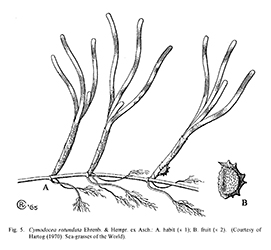e-Flora of Thailand
Volume 7 > Part 3 > Year 2001 > Page 362 > Cymodoceaceae > Cymodocea
Cymodocea rotundata Ehrenb. & Hempr, ex Asch.
Sitz.-Ber. Ges. Naturfr. Berlin 1870: 84. 1870; Hartog, Sea-grasses of the World, 166, f. 47. 1970; Hook.f., Fl. Brit. Ind. 6: 570. 1894, Beijing, Fl. Reipubl. Popularis Sin. 8: 107, f. 43. 1992. Fig. 5.
Accepted Name : This is currently accepted.
Description : Plants to 30 cm tall; rhizomes delicate, with 1–3 irregularly branched roots at each node. Leaves with sheath slightly obconical, pale purblish, 1.4–5 cm long, fibrous, auricles acute; blade linear, often falcate, 7–16 cm by 2–4 mm, entire to rarely spinulose, apex faintly serrulate. Staminate flower with anthers ca 11 mm long; carpellate flower with very small ovary that gradually passes into the style, the two together ca 5 mm long, stigmata ca 30 mm long, spirally coiled. Fruit 1 or 2 together, sessile, semicircular, ca 10 by ca 6 mm, ca 1.5 mm thick, with 1 adaxial ridge bearing 3–4 teeth and 3 abaxial ridges, central one with 6–8 conspicuous teeth.
Thailand : PENINSULAR: Phangnga, Phuket, Krabi.
Distribution : As the genus.
Ecology : Marine waters below low water mark so that the plants are exposed only during spring ebbs. The species is found especially in sand spots of coral reefs but occasionally forms large mats on muddy flats. It also can tolerate lower salinities; consequently, it occasionally is found in some estuaries.
E-version notes : As Cymodocea rotundata Asch. & Schweinf., Sitzungsber. Ges. Naturf. Freunde Berlin 1870: 84. 1870.

